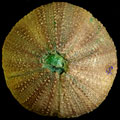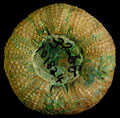The Echinoid Directory
Scoliechinus Arnold & Clark, 1927, p. 23
| Diagnostic Features |
|
|---|---|
| Distribution | Middle Eocene, Yellow Limestone Group of Jamaica |
| Name gender | masculine |
| Type | Scoliechinus axiologus Arnold & Clark, 1927, by original designation. Holotype: Museum of Comparative Zoology, Harvard 101824. |
| Species Included |
|
| Classification and/or Status |
|
| Remarks |
|



